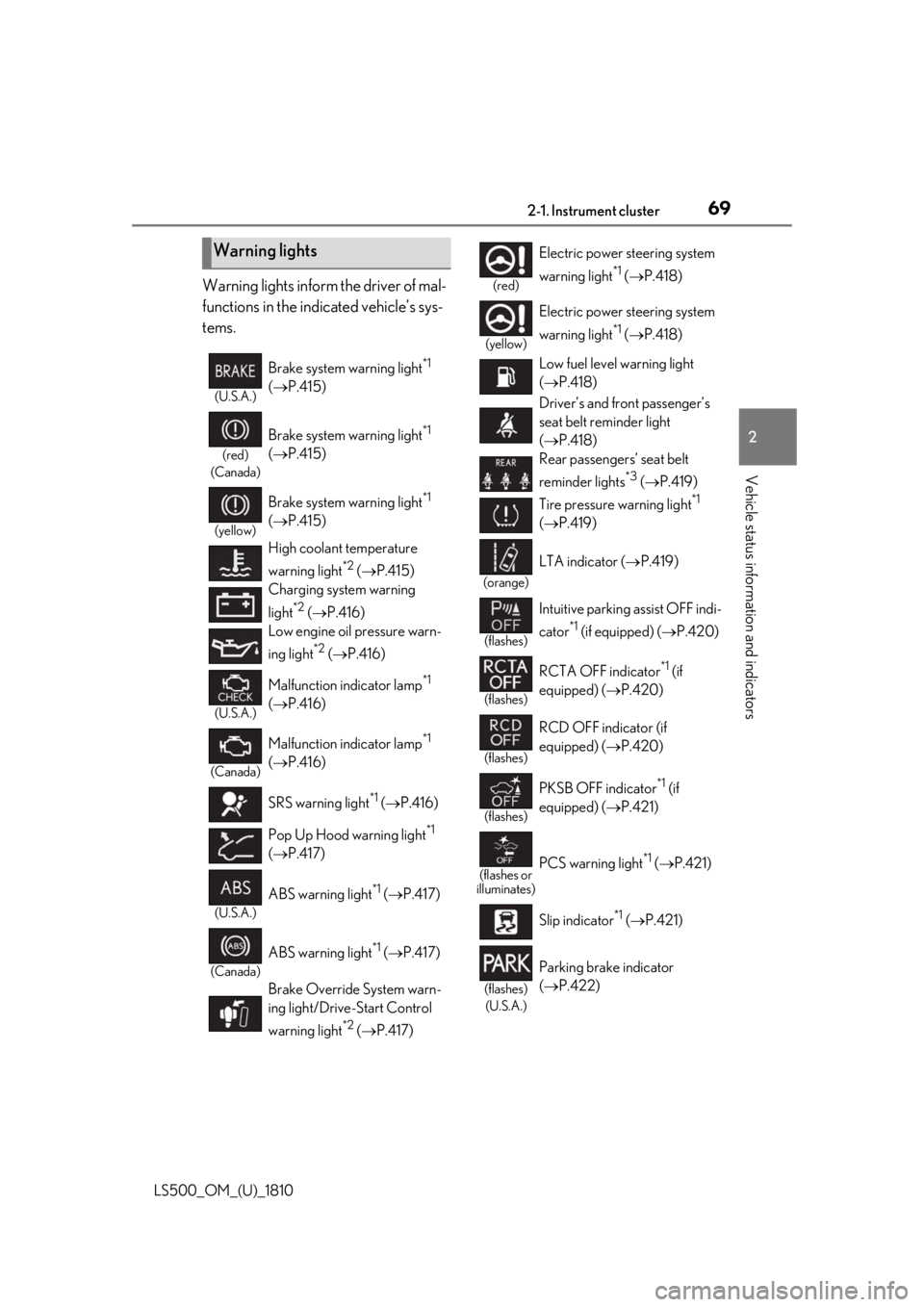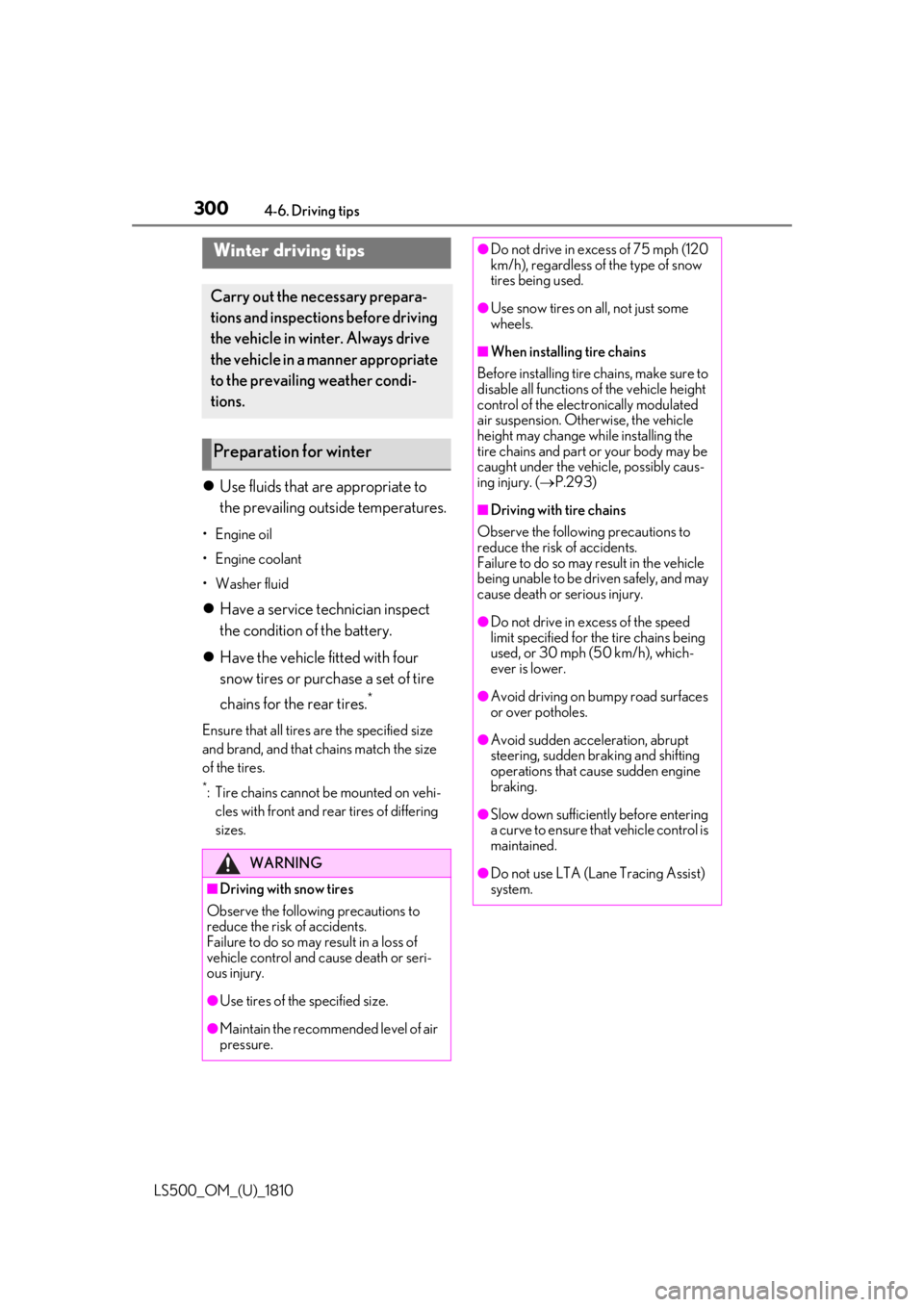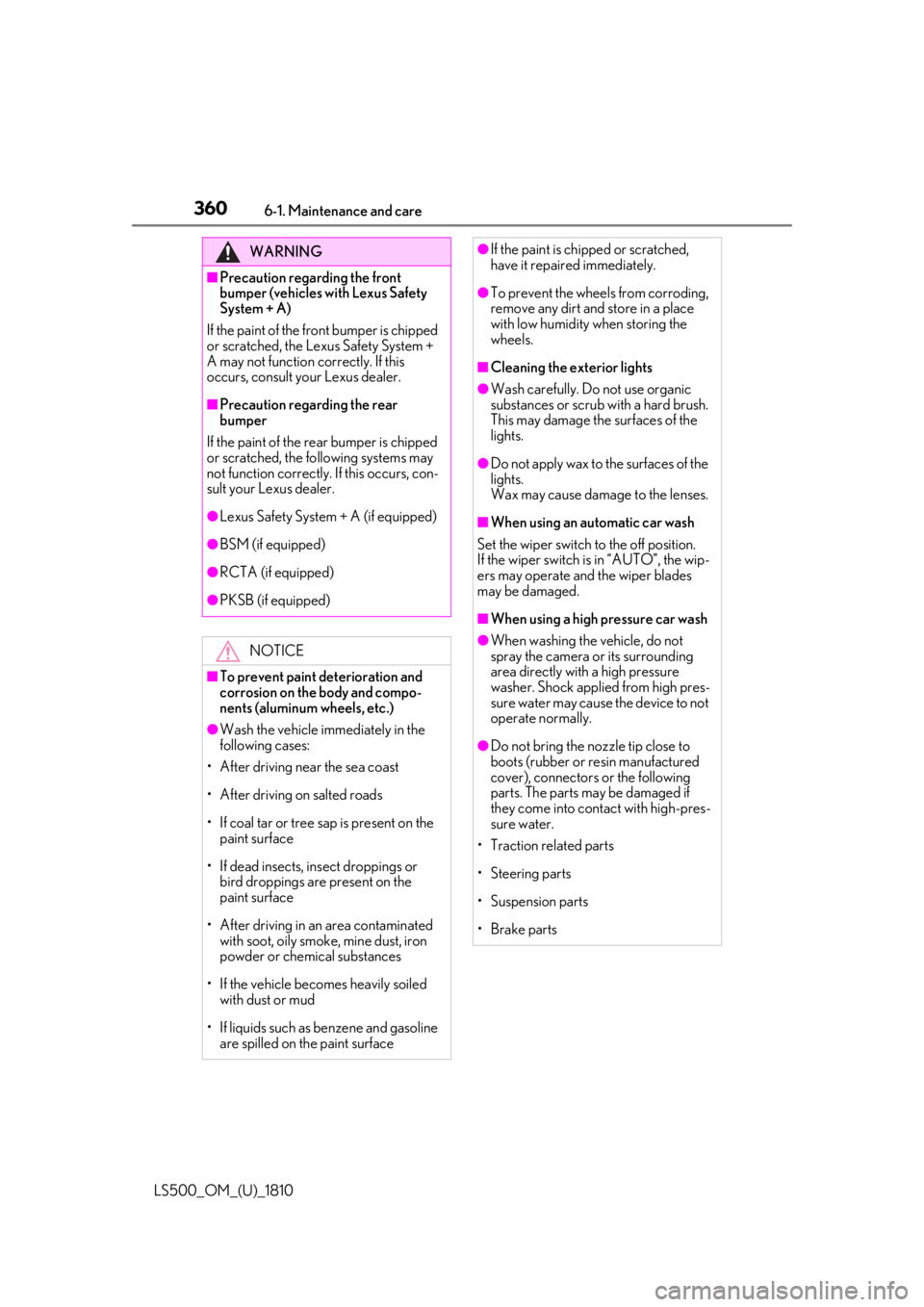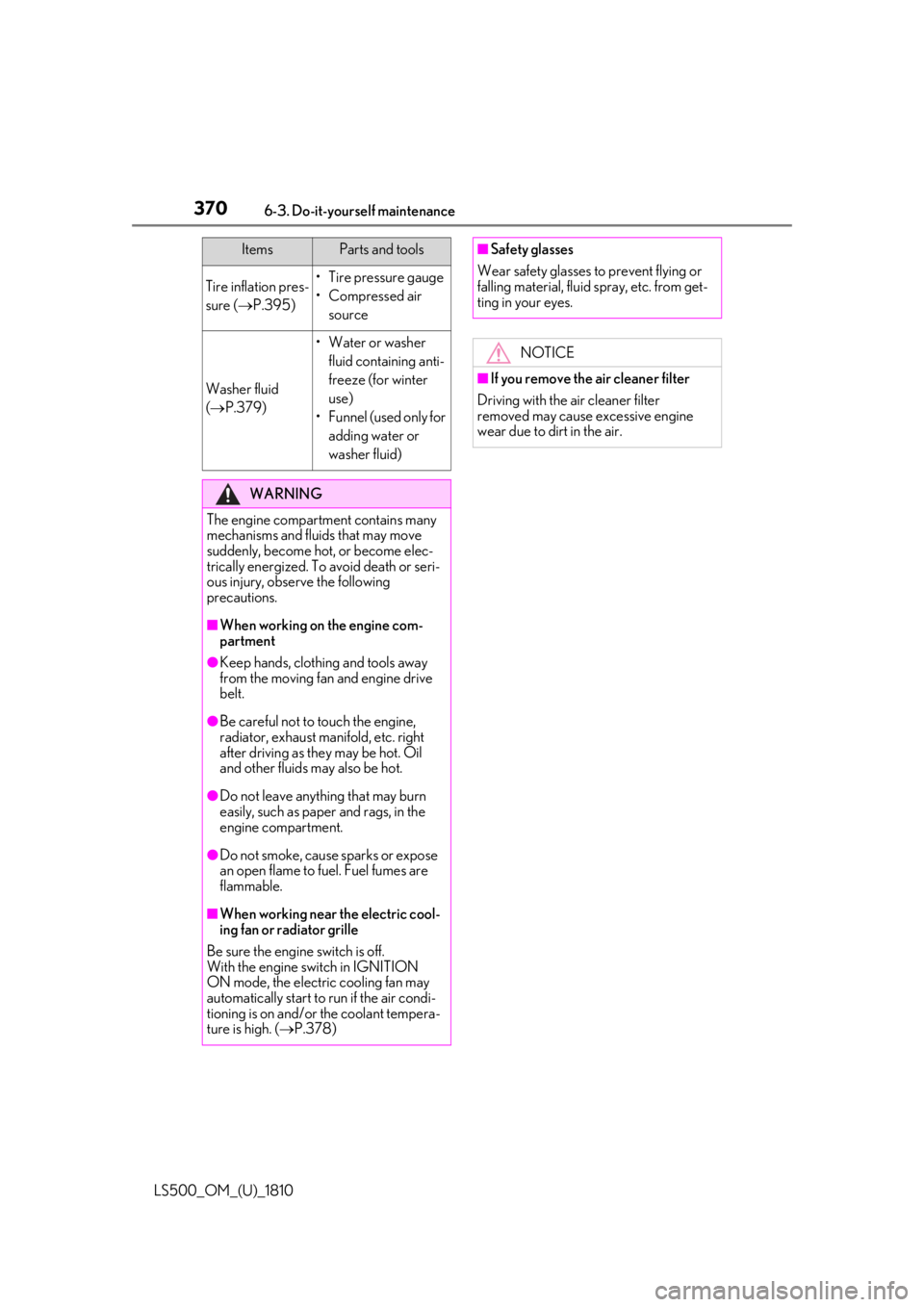2019 LEXUS LS500 oil pressure
[x] Cancel search: oil pressurePage 1 of 512

LS500_OM_(U)_1810 1
2
3
4
5
6
7
8
9Pictorial index Search by illustration
For safety
and security Make sure to read through them
(Main topics: Child seat, theft deterrent system)
Vehicle status
information and
indicators Reading driving-related information
(Main topics: Meters, multi-information display)
Before driving Opening and closing the doors and windows,
adjustment before driving
(Main topics: Keys, doors, seats)
Driving Operations and advice which are necessary for driving
(Main topics: Starting engine, refueling)
Interior features Usage of the interior features
(Main topics: Air conditioner, storage features)
Maintenance
and care Caring for your vehicle and maintenance procedures
(Main topics: Interior and exterior, light bulbs)
When trouble
arises What to do in case of malfunction and emergency
(Main topics: Battery discharge, flat tire)
Vehicle
specifications Vehicle specifications, customizable features
(Main topics: Fuel, oil, tire inflation pressure)
For owners Reporting safety defects for U.S. owners, seat belt and
SRS airbag instructions for Canadian owners
Index Search by symptom
Search alphabetically
Page 4 of 512

4 TABLE OF CONTENTS
LS500_OM_(U)_1810 5-6. Using the other interior features
Other interior features .............. 343
Garage door opener.................. 350
6-1. Maintenance and care
Cleaning and protecting the vehi-
cle exterior ................................... 358
Cleaning and protecting the vehi-
cle interior ..................................... 361
6-2. Maintenance
Maintenance requirements ..... 364
General maintenance ................ 365
Emission inspection and mainte-
nance (I/M) programs ............ 368
6-3. Do-it-yourself maintenance
Do-it-yourself service precautions
........................................................... 369
Hood................................................... 371
Positioning a floor jack................ 371
Engine compartment.................. 373
Battery .............................................. 380
Tires ................................................... 382
Replacing the tire .......................... 391
Tire inflation pressure ................. 395
Wheels.............................................. 396
Air conditioning filter.................. 398
Electronic key battery ................ 399
Checking and replacing fuses
............................................................ 401
Light bulbs ....................................... 404 7-1. Essential information
Emergency flashers .................... 406
If your vehicle has to be stopped in
an emergency ............................ 406
If the vehicle is trapped in rising
water .............................................. 407
7-2. Steps to take in an emergency
If your vehicle needs to be towed
.......................................................... 409
If you think something is wrong
............................................................ 413
Fuel pump shut off system .......... 414
If a warning light turns on or a warn-
ing buzzer sounds...................... 415
If a warning messa ge is displayed
.......................................................... 425
If you have a flat tire .................... 429
If the engine will not start .......... 430
If you lose your keys.................... 432
If the fuel filler door cannot be
opened .......................................... 432
If the electronic key does not oper-
ate properly ................................. 433
If the vehicle battery is discharged
.......................................................... 435
If your vehicle overheats ........... 440
If the vehicle becomes stuck ... 443
8-1. Specifications
Maintenance data (fuel, oil level,
etc.) ................................................. 446
Fuel information............................ 4556
Maintenance and care 7
When trouble arises
8
Vehicle specifications
Page 13 of 512

13Pictorial index
LS500_OM_(U)_1810 Precautions for winter season .. .................................................................................. P.300
To prevent freezing (windshield wiper de-icer) *
.................................................. P.318
Precautions for car wash ...............................................................................................P.359
Fuel filler door ..........................................................................................................P.189
Refueling method .............................................................................................................. P .189
Fuel type/fuel tank capacity ...... ................................................................................... P.447
Tires.......................................................................................................................... .P.382
Tire size/inflation pressure ............................................................................... P.382, 452
Winter tires/tire chains ................................................................................................. P.300
Checking/rotation/tire pressu re warning system..............................................P.382
Coping with flat tires........................................................................................................ P .429
Hood ........................................................................................................................... P.371
Opening ........................................................................................................................ .........P.371
Engine compartment cover ......................................................................................... P.374
Engine oil ..................................................................................................................... ......... P.448
Coping with overheating ............................................................................................... P.440
Warning messages .......................................................................................................... P.425
Headlights/cornering lights ................................................................................ P.179
Parking lights/daytime running lights............................................................... P.179
Turn signal lights ...................................................................................................... P.173
Tail lights .................................................................................................................... P.179
Stop lights
Hill-start assist control .................................................................................................... P. 295
License plate lights ................................................................................................. P.179
Back-up lights
Changing the shift position to R....................................................................................P.167
Side marker lights ................................................................................................... P.179 *
:If equipped Light bulbs of the exterior lights for driving
(Replacing method: P.404) E
F
G
H
I
J
K
L
M
N
Page 69 of 512

692-1. Instrument cluster
LS500_OM_(U)_1810 2
Vehicle status information and indicators Warning lights inform the driver of mal-
functions in the indicated vehicle’s sys-
tems.
Warning lights (U.S.A.)
Brake system warning light *1
( P.415)(red)
(Canada)
Brake system warning light *1
( P.415)(yellow)
Brake system warning light *1
( P.415)
High coolant temperature
warning light *2
( P.415)
Charging system warning
light *2
( P.416)
Low engine oil pressure warn-
ing light *2
( P.416)(U.S.A.)
Malfunction indicator lamp *1
( P.416)
(Canada)
Malfunction indicator lamp *1
( P.416)
SRS warning light *1
( P.416)
Pop Up Hood warning light *1
( P.417)
(U.S.A.)
ABS warning light *1
( P.417)
(Canada)
ABS warning light *1
( P.417)
Brake Override System warn-
ing light/Drive-Start Control
warning light *2
( P.417) (red)
Electric power steering system
warning light *1
( P.418)(yellow)
Electric power steering system
warning light *1
( P.418)
Low fuel level warning light
( P.418)
Driver’s and front passenger’s
seat belt reminder light
( P.418)
Rear passengers’ seat belt
reminder lights *3
( P.419)
Tire pressure warning light *1
( P.419)(orange)
LTA indicator ( P.419)
(flashes)
Intuitive parking assist OFF indi-
cator *1
(if equipped) ( P.420)
(flashes)
RCTA OFF indicator *1
(if
equipped) ( P.420)
(flashes)
RCD OFF indicator (if
equipped) ( P.420)
(flashes)
PKSB OFF indicator *1
(if
equipped) ( P.421)
(flashes or
illuminates)
PCS warning light *1
( P.421)
Slip indicator *1
( P.421)
(flashes)
(U.S.A.) Parking brake indicator
( P.422)
Page 228 of 512

228 4-5. Using the driving support systems
LS500_OM_(U)_1810 ■
Lane departure alert function
When the system determines that the
vehicle might depart from its lane or
course *
, a warning is displayed on the
multi-information display, and either a
warning buzzer will sound or the steer-
ing wheel will vibrate to alert the driver.
When the warning buzzer sounds or
the steering wheel vibrates, check the
area around your vehicle and carefully
operate the steering wheel to move the
vehicle back to the center of the lane.
When the system determines that the
vehicle might depart from its lane and
that the possibility of a collision with an
overtaking vehicle in the adjacent lane
is high, the lane departure alert will
operate even if the turn signals are
operating. *
: Boundary between asphalt and the side
of the road, such as grass, soil, or a curbWARNING●
The traffic lines are yellow (which may
be more difficult to recognize than
lines that are white).●
The white (yellow) lines cross over a
curb, etc.●
The vehicle is driven on a bright sur-
face, such as concrete.●
If the edge of the road is not clear or
straight.●
The vehicle is driven on a surface that
is bright due to reflected light, etc.●
The vehicle is driven in an area where
the brightness changes suddenly, such
as at the entrances and exits of tunnels,
etc.●
Light from the headlights of an oncom-
ing vehicle, the sun, etc. enters the
camera.●
The vehicle is driven on a slope.●
The vehicle is driven on a road which
tilts left or right, or a winding road.●
The vehicle is driven on an unpaved or
rough road.
●
The traffic lane is excessively narrow
or wide.
●
The vehicle is extremely tilted due to
carrying heavy luggage or having
improper tire pressure.
●
The distance to the preceding vehicle
is extremely short.
●
The vehicle is moving up and down a
large amount due to road conditions
during driving (poor roads or road
seams).
●
When driving in a tunnel or at night
with the headlights off or when a head-
light is dim due to its lens being dirty or
it being misaligned.
●
The vehicle is struck by a crosswind. ●
The vehicle is affected by wind from a
vehicle driven in a nearby lane. ●
The vehicle has just changed lanes
through operation of the steering
wheel by the driver or crossed an
intersection. ●
Tires which differ by structure, manu-
facturer, brand or tread pattern are
used. ●
Snow tires, etc. are equipped. ●
The vehicle is being driven at
extremely high speeds.
Functions included in LTA system
Page 300 of 512

300 4-6. Driving tips
LS500_OM_(U)_1810 4-6.Driving tips
Use fluids that are appropriate to
the prevailing outside temperatures. •Engine oil
• Engine coolant
•Washer fluid
Have a service technician inspect
the condition of the battery.
Have the vehicle fitted with four
snow tires or purchase a set of tire
chains for the rear tires. *
Ensure that all tires are the specified size
and brand, and that chains match the size
of the tires. *
: Tire chains cannot be mounted on vehi-
cles with front and rear tires of differing
sizes.Winter driving tips Carry out the necessary prepara-
tions and inspections before driving
the vehicle in winter. Always drive
the vehicle in a manner appropriate
to the prevailing weather condi-
tions.
Preparation for winter
WARNING
■
Driving with snow tires
Observe the following precautions to
reduce the risk of accidents.
Failure to do so may result in a loss of
vehicle control and cause death or seri-
ous injury.
●
Use tires of the specified size.
●
Maintain the recommended level of air
pressure. ●
Do not drive in excess of 75 mph (120
km/h), regardless of the type of snow
tires being used. ●
Use snow tires on all, not just some
wheels. ■
When installing tire chains
Before installing tire chains, make sure to
disable all functions of the vehicle height
control of the electronically modulated
air suspension. Otherwise, the vehicle
height may change while installing the
tire chains and part or your body may be
caught under the vehicle, possibly caus-
ing injury. ( P.293)■
Driving with tire chains
Observe the following precautions to
reduce the risk of accidents.
Failure to do so may result in the vehicle
being unable to be driven safely, and may
cause death or serious injury. ●
Do not drive in excess of the speed
limit specified for the tire chains being
used, or 30 mph (50 km/h), which-
ever is lower. ●
Avoid driving on bumpy road surfaces
or over potholes. ●
Avoid sudden acceleration, abrupt
steering, sudden br aking and shifting
operations that cause sudden engine
braking.
●
Slow down sufficiently before entering
a curve to ensure that vehicle control is
maintained.
●
Do not use LTA (Lane Tracing Assist)
system.
Page 360 of 512

360 6-1. Maintenance and care
LS500_OM_(U)_1810 WARNING■
Precaution regarding the front
bumper (vehicles with Lexus Safety
System + A)
If the paint of the fr ont bumper is chipped
or scratched, the Le xus Safety System +
A may not function correctly. If this
occurs, consult your Lexus dealer. ■
Precaution regarding the rear
bumper
If the paint of the rear bumper is chipped
or scratched, the fo llowing systems may
not function correctly. If this occurs, con-
sult your Lexus dealer. ●
Lexus Safety System + A (if equipped)●
BSM (if equipped)●
RCTA (if equipped)●
PKSB (if equipped)
NOTICE■
To prevent paint deterioration and
corrosion on the body and compo-
nents (aluminum wheels, etc.)●
Wash the vehicle immediately in the
following cases:
• After driving near the sea coast
• After driving on salted roads
• If coal tar or tree sap is present on the
paint surface
• If dead insects, in sect droppings or
bird droppings are present on the
paint surface
• After driving in an area contaminated
with soot, oily smoke, mine dust, iron
powder or chemical substances
• If the vehicle becomes heavily soiled
with dust or mud
• If liquids such as benzene and gasoline
are spilled on the paint surface ●
If the paint is chipped or scratched,
have it repaired immediately. ●
To prevent the wheels from corroding,
remove any dirt and store in a place
with low humidity when storing the
wheels. ■
Cleaning the exterior lights ●
Wash carefully. Do not use organic
substances or scrub with a hard brush.
This may damage the surfaces of the
lights. ●
Do not apply wax to the surfaces of the
lights.
Wax may cause damage to the lenses. ■
When using an automatic car wash
Set the wiper switch to the off position.
If the wiper switch is in “AUTO”, the wip-
ers may operate and the wiper blades
may be damaged. ■
When using a high pressure car wash ●
When washing the vehicle, do not
spray the camera or its surrounding
area directly with a high pressure
washer. Shock applied from high pres-
sure water may cause the device to not
operate normally. ●
Do not bring the nozzle tip close to
boots (rubber or re sin manufactured
cover), connectors or the following
parts. The parts may be damaged if
they come into contact with high-pres-
sure water.
• Traction related parts
•Steering parts
• Suspension parts
• Brake parts
Page 370 of 512

370 6-3. Do-it-yourself maintenance
LS500_OM_(U)_1810 Tire inflation pres-
sure ( P.395) • Tire pressure gauge
•Compressed air
source
Washer fluid
( P.379) • Water or washer
fluid containing anti-
freeze (for winter
use)
• Funnel (used only for
adding water or
washer fluid)
WARNING
The engine compartment contains many
mechanisms and fluids that may move
suddenly, become hot, or become elec-
trically energized. To avoid death or seri-
ous injury, observe the following
precautions. ■
When working on the engine com-
partment●
Keep hands, clothi ng and tools away
from the moving fan and engine drive
belt.●
Be careful not to touch the engine,
radiator, exhaust manifold, etc. right
after driving as they may be hot. Oil
and other fluids may also be hot.
●
Do not leave anything that may burn
easily, such as paper and rags, in the
engine compartment.
●
Do not smoke, cause sparks or expose
an open flame to fuel. Fuel fumes are
flammable.
■
When working near the electric cool-
ing fan or radiator grille
Be sure the engine switch is off.
With the engine switch in IGNITION
ON mode, the electric cooling fan may
automatically start to run if the air condi-
tioning is on and/or the coolant tempera-
ture is high. ( P.378)Items Parts and tools ■
Safety glasses
Wear safety glasses to prevent flying or
falling material, fluid spray, etc. from get-
ting in your eyes.
NOTICE■
If you remove the air cleaner filter
Driving with the air cleaner filter
removed may cause excessive engine
wear due to dirt in the air.